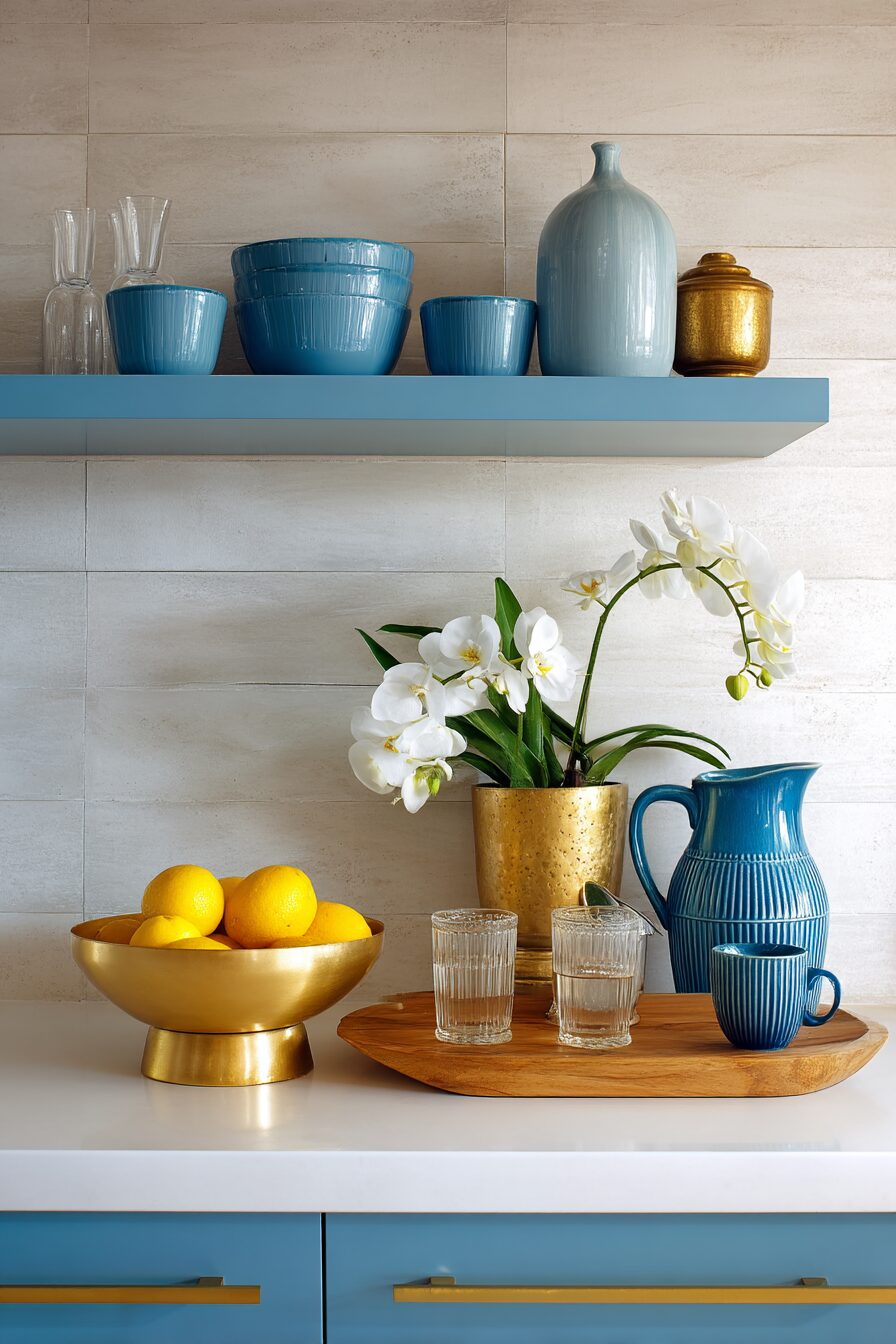The heart of every home beats strongest in the kitchen, but there’s something uniquely magical about the kitchens our grandmothers created.
That perfect blend of practicality, comfort, and timeless charm that somehow made every meal taste better and every conversation feel warmer.
Grandmacore design recaptures this essence, bringing together vintage aesthetics with functionality that works for today’s lifestyle.
Ready to transform your kitchen into a cozy sanctuary that serves up nostalgia alongside your favorite recipes?
These top grandmacore kitchen ideas will guide you through creating a space that feels like a warm hug every time you enter.
✨Click to Get My 101 FREE Designer Room Ideas
Vintage Appliances with Modern Functionality
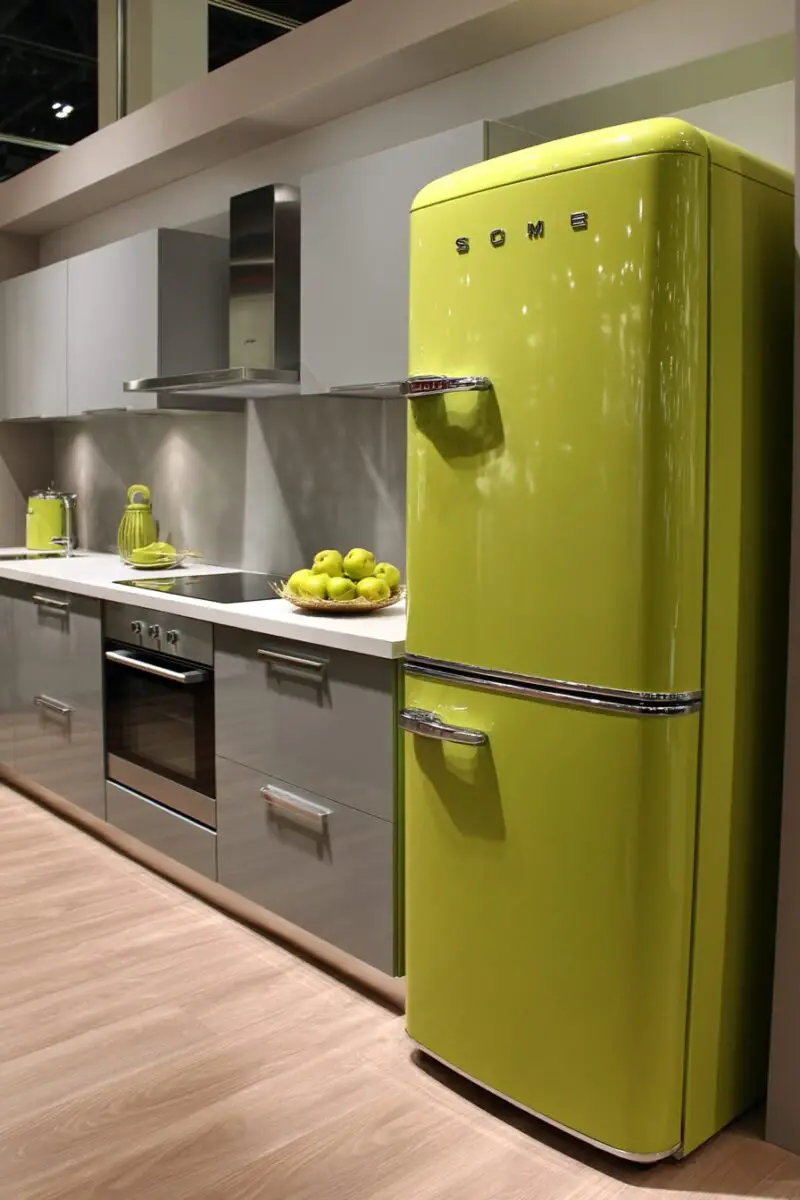
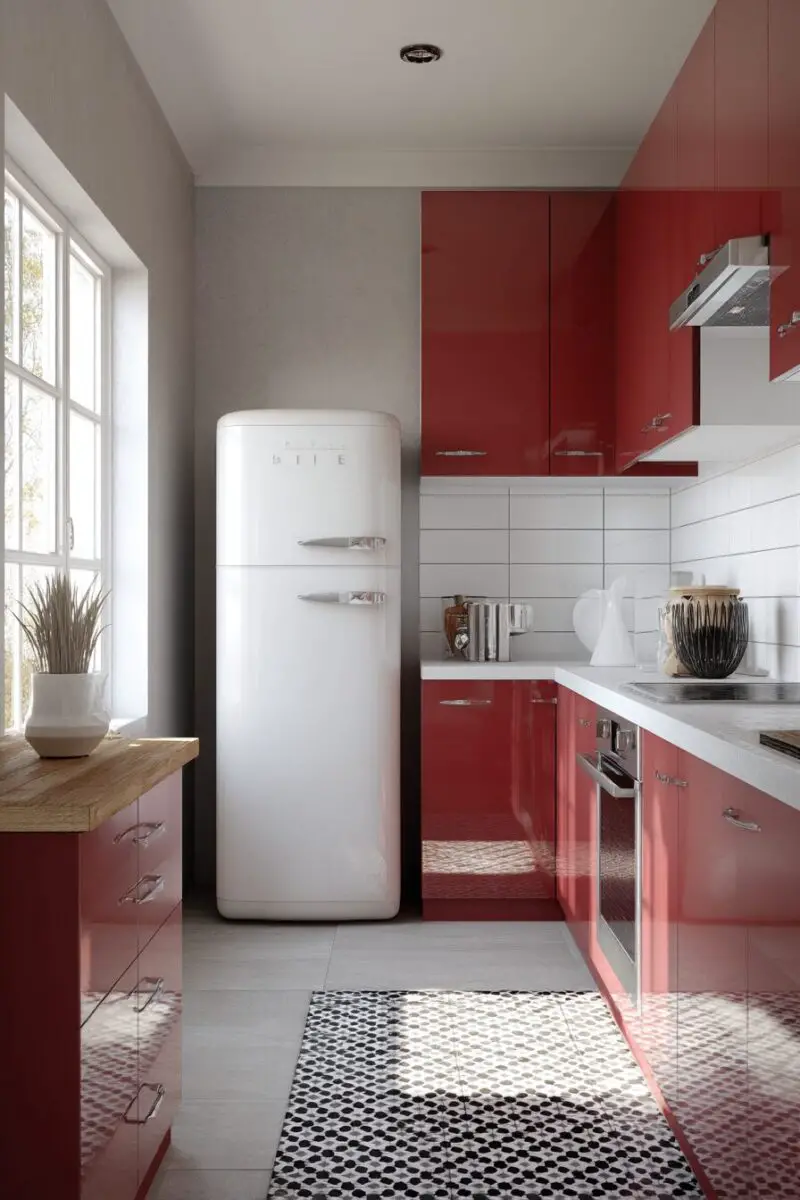
That pastel mint refrigerator or cherry-red stand mixer isn’t just a pretty face – it’s a time machine to simpler days filled with homemade goodness.
Vintage-inspired appliances have made a remarkable comeback, now offering modern functionality while wrapping it in nostalgia’s warm embrace.
Companies like SMEG, Big Chill, and Elmira Stove Works specialize in creating these retro treasures that perform like champions while looking like they’ve been transported straight from grandma’s 1950s kitchen.
These charming cooling giants combine old-school rounded edges and chrome details with modern features like energy efficiency and adjustable shelving.
Countertop appliances offer another opportunity to embrace vintage charm without committing to larger investments.
A mint green or cream-colored stand mixer displayed prominently tells visitors this kitchen is made for serious baking sessions just like grandma used to host.
Retro toasters, percolators, and electric kettles in bold colors or classic chrome add functional nostalgia to your daily routine.
For the truly dedicated, restored vintage stoves from brands like O’Keefe & Merritt or Chambers can be found through specialty restorers who ensure these historical beauties meet modern safety standards.
The beauty of these appliances extends beyond mere appearance – their solid construction and timeless design often outlast many modern counterparts.
When selecting vintage or vintage-inspired appliances, look for pieces that combine authentic details with practical features you’ll actually use.
An avocado green blender might look perfect on your counter, but if it can’t handle your morning smoothie routine, it’s merely decoration.
Balance is key – aim for a kitchen where nostalgia enhances rather than hinders your cooking experience.
Remember that true grandmacore isn’t about creating a museum – it’s about crafting a living, breathing space where memories are actively made.
Mixing genuine vintage finds with quality reproductions allows you to honor the past while embracing modern conveniences.
The sounds of these appliances – the distinctive click of a mechanical timer or the gentle hum of an old-school refrigerator – add another sensory layer to your grandmacore experience.
Let these faithful kitchen companions tell their stories through both their appearance and the meals they help you create.
Open Shelving with Antique Dishware Displays
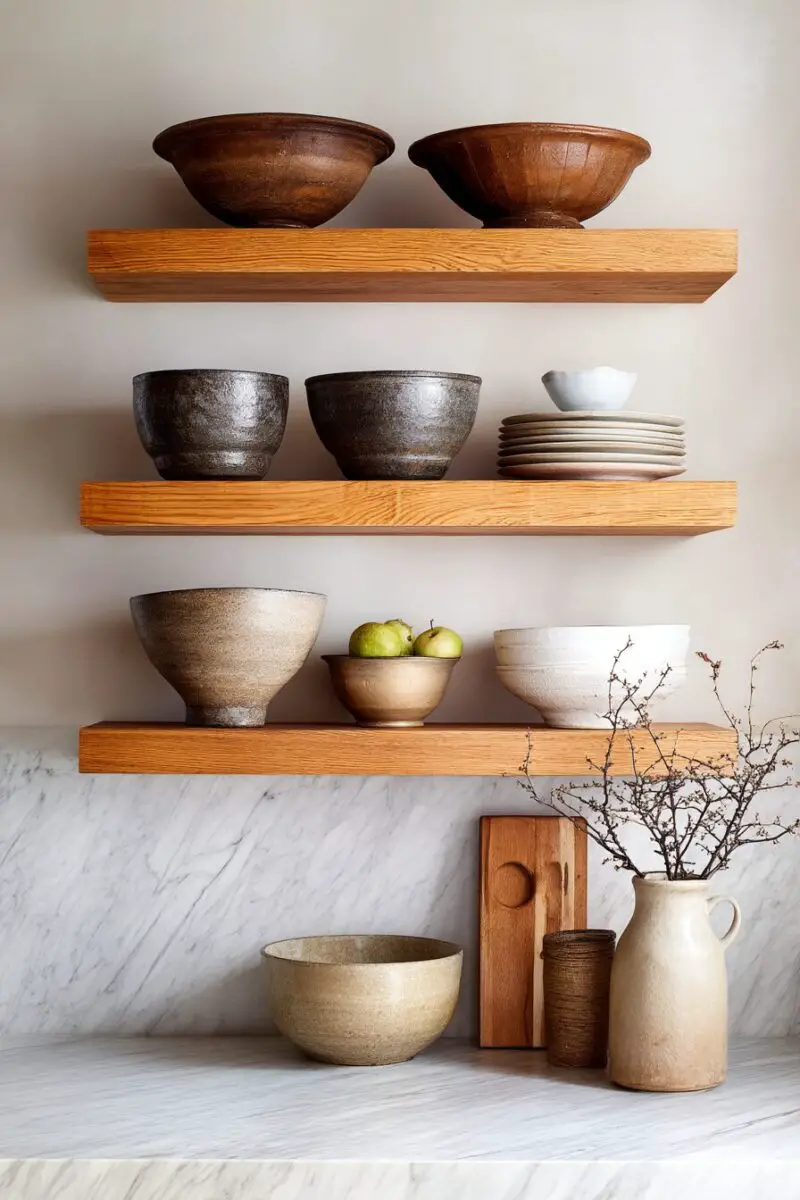
Nothing captures grandmacore essence quite like the gleam of carefully collected dishes and glassware arranged on open shelves, telling stories of meals shared and traditions honored.
Open shelving transforms your everyday dishes and vintage treasures into an ever-changing art display that adds character and warmth to your kitchen.
The key to this look lies not in perfectly matched sets, but in the thoughtful curation of pieces collected over time – the jadeite mixing bowls, the hand-painted teacups, the amber glassware that catches afternoon light.
Installing simple wooden shelves with wrought iron brackets instantly creates that unfussy, lived-in feeling that defines grandmacore design.
White beadboard backing behind your shelves adds textural interest and a clean backdrop that makes colorful dishware pop even more.
Depression glass in soft pinks and greens, Blue Willow patterns, and classic Pyrex mixing bowls in primary colors all contribute to that nostalgic feeling that makes visitors exclaim, “This reminds me of my grandmother’s kitchen!”
The beauty of open shelving lies in its practicality – these aren’t just pretty displays but functional storage solutions that keep your most-used items within easy reach.
Arrange your collection with a thoughtful eye, placing everyday items at eye level and special occasion pieces higher up where they can be admired but protected.
Don’t worry about creating perfect symmetry – the charm comes from a collected-over-time look that tells your personal story.
Mix in practical elements like mason jars filled with dry goods, crocks holding wooden spoons, or wire baskets containing cloth napkins.
Height variations add visual interest, so alternate stacks of plates with standing platters and different-sized serving bowls.
Remember that negative space is important too – avoid overcrowding your shelves, which can quickly transform charming displays into chaotic clutter.
Lighting plays a crucial role in showcasing your collections, so consider adding small LED strip lights under shelves to illuminate your treasures in the evening.
Seasonal rotation keeps your kitchen feeling fresh – swap in holiday-specific pieces or change color schemes to reflect the changing calendar.
The stories behind your pieces matter as much as their appearance – that chipped teacup from your great-aunt’s collection or the serving platter that’s seen fifty Thanksgiving dinners adds the authentic character that mass-produced replicas can’t match.
When styling your shelves, create small vignettes around themes – morning coffee station, baking essentials, or afternoon tea collection.
Embrace imperfection – the slightly worn edges and faded patterns speak to items that have been genuinely loved and used.
Floral Wallpaper and Fabric Accents

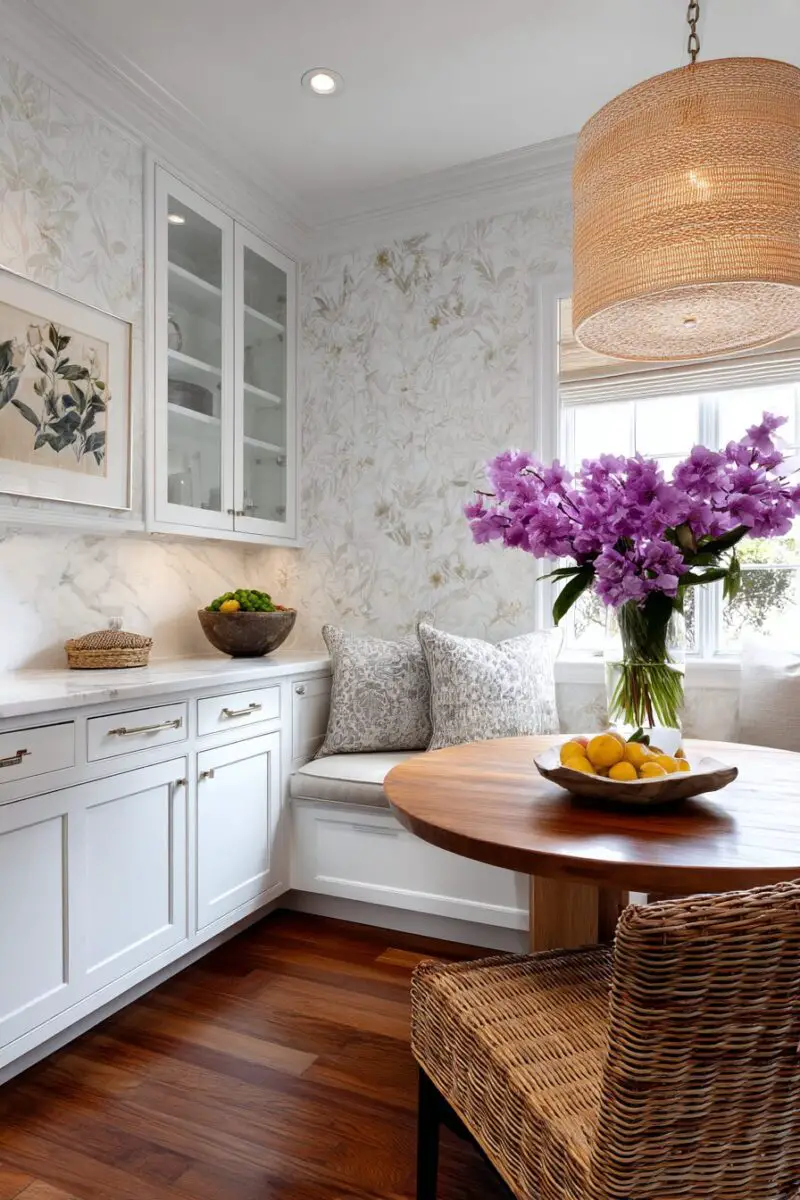
Those blooming peonies climbing your kitchen walls aren’t just pretty decoration – they’re portals to a time when kitchens welcomed nature’s beauty indoors regardless of passing trends.
Floral patterns have graced grandmother’s kitchens for generations, creating warm, inviting spaces that feel alive with color and personality.
Today’s floral wallpapers offer updated takes on this classic style, from large-scale dramatic blooms to delicate vintage-inspired patterns that capture nostalgia without feeling dated.
Modern peel-and-stick options make this transformation more accessible than ever, allowing even renters to embrace this charming design element.
For a truly authentic touch, look for reproduction wallpapers featuring patterns from the 1940s through 1960s – the golden age of floral kitchen design.
Coordinate your wallpaper with fabric accents throughout the space for a cohesive yet not-too-matchy feeling that grandmothers naturally mastered.
Café curtains in complementary floral prints filter light beautifully while adding privacy and another layer of pattern to your design.
Hand-sewn pot holders hanging from hooks, a fabric skirt concealing under-sink storage, or cushions on breakfast nook seating continue the floral story throughout the room.
Don’t shy away from mixing patterns – the trick lies in varying the scale while keeping within a harmonious color palette.
A large-scale wallpaper bloom pairs beautifully with smaller floral printed textiles, creating depth and interest without overwhelming the eye.
Color choices matter tremendously in floral designs – soft pastels create a gentle, dreamy quality while bolder hues energize the space.
When working with dominant floral elements, balance them with solid colors and natural materials elsewhere in the kitchen to prevent pattern overload.
Vintage floral-patterned dishware displayed prominently creates conversation-starting connections between your walls and everyday objects.
For a subtle approach, limit florals to smaller accents like tea towels, aprons displayed on hooks, or framed botanical prints grouped on a wall.
Remember that grandmacore isn’t about perfection – allowing these patterns to show some wear or choosing wallpaper with a slightly faded quality adds to the lived-in charm.
Seasonal changes can be reflected through simple textile swaps – darker, richer florals for fall and winter, brighter blooms for spring and summer.
The secret to successful floral integration lies in creating a space that feels collected over time rather than designed in a single shopping trip.
Farmhouse Sink and Classic Faucets
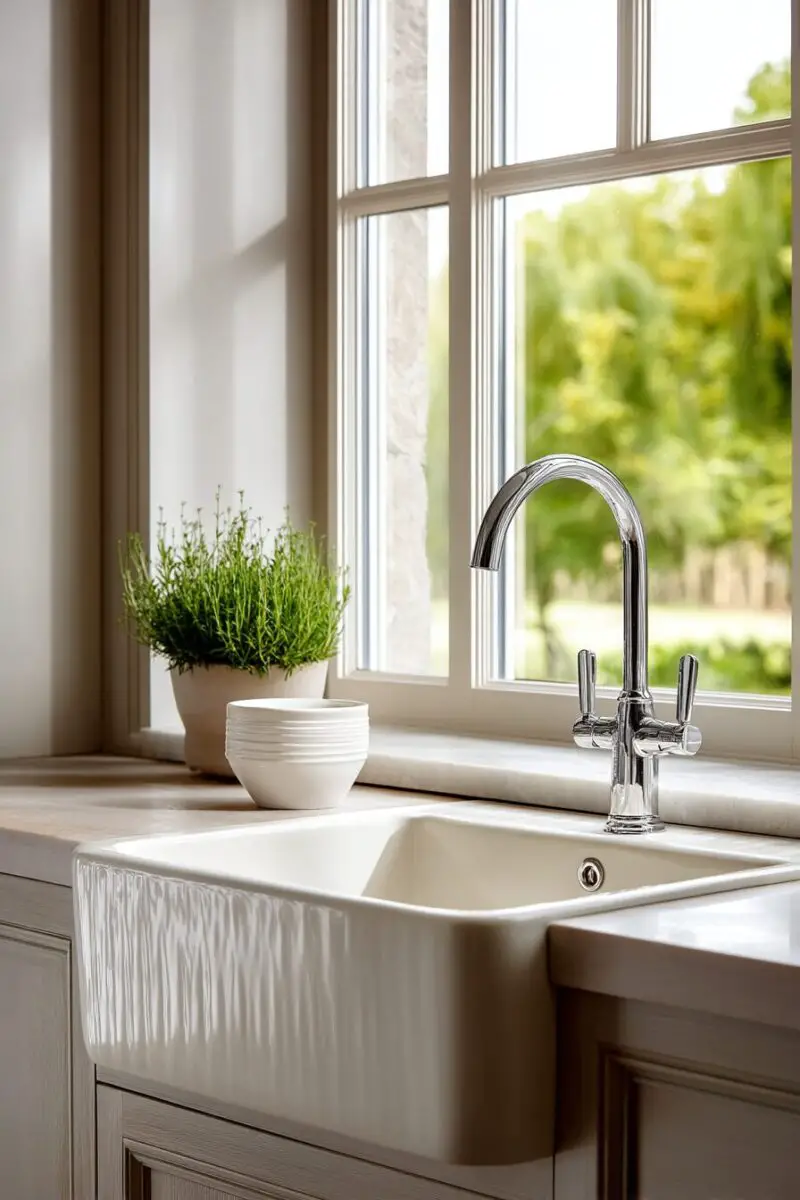

That deep, white farmhouse sink isn’t just a practical washing station – it’s a nostalgic centerpiece that transforms everyday chores into rituals connecting you to generations of home cooks before you.
Farmhouse (or apron-front) sinks extend slightly beyond cabinetry, showcasing their substantial fronts and offering generous depth that accommodates everything from holiday roasting pans to flower-arranging projects.
Traditional fireclay or porcelain options in crisp white deliver that quintessential grandmother’s kitchen look, developing subtle patina over years that tells the story of meals prepared and memories made.
Modern versions come in various materials including stainless steel, copper, or even concrete, allowing you to honor tradition while adapting to your personal style preferences.
The substantial size of these sinks speaks to an era when dishes were washed by hand and large family meals were the norm – practical considerations that translate beautifully to today’s cooking enthusiasts.
Pairing your farmhouse sink with the right faucet elevates the entire look, with bridge-style faucets in brushed brass, copper, or oil-rubbed bronze offering authentic vintage appeal.
Look for faucets with cross handles rather than levers for that extra touch of grandmacore authenticity that transforms daily use into a tactile pleasure.
The installation of a farmhouse sink often requires custom cabinetry consideration, making it an investment piece that deserves careful planning and quality craftsmanship.
For a truly authentic touch, search architectural salvage yards for genuine vintage sinks that can be restored and retrofitted to modern plumbing – though be prepared for the potential challenges this route may present.
The area surrounding your sink offers additional opportunities for grandmacore charm – a small shelf above holding hand soap in a vintage dish, perhaps, or a window with cafe curtains framing the washing area.
The gentle slope of the farmhouse sink’s interior makes it ideal for growing small pots of kitchen herbs on the windowsill above, bringing life and freshness to your washing station.
Embrace the practical beauty of sink accessories like wooden drying racks, ceramic soap dishes, or a small vase of fresh-cut flowers from the garden that can transform mundane washing into a multisensory experience.
The substantial presence of a farmhouse sink naturally creates a focal point in your kitchen, so allow it adequate visual space rather than crowding surrounding areas.
For ultimate grandmacore authenticity, consider adding a dedicated dish towel bar on the cabinet face adjacent to your sink, displaying hand-embroidered or vintage linens within easy reach.
The sound of water filling a deep farmhouse sink creates its own kind of kitchen music – a sensory detail that adds to the immersive experience of your grandmacore kitchen.
Remember that these sinks were designed for hard work and daily use – don’t be afraid to actually use yours for everything from washing garden vegetables to dyeing Easter eggs with children.
Unlike undermount or drop-in versions, the exposed front of farmhouse sinks allows for decorative details like fluting or embossed patterns that add subtle texture to your kitchen design.
✨Click to Get My 101 FREE Designer Room Ideas
Warm Wood Elements

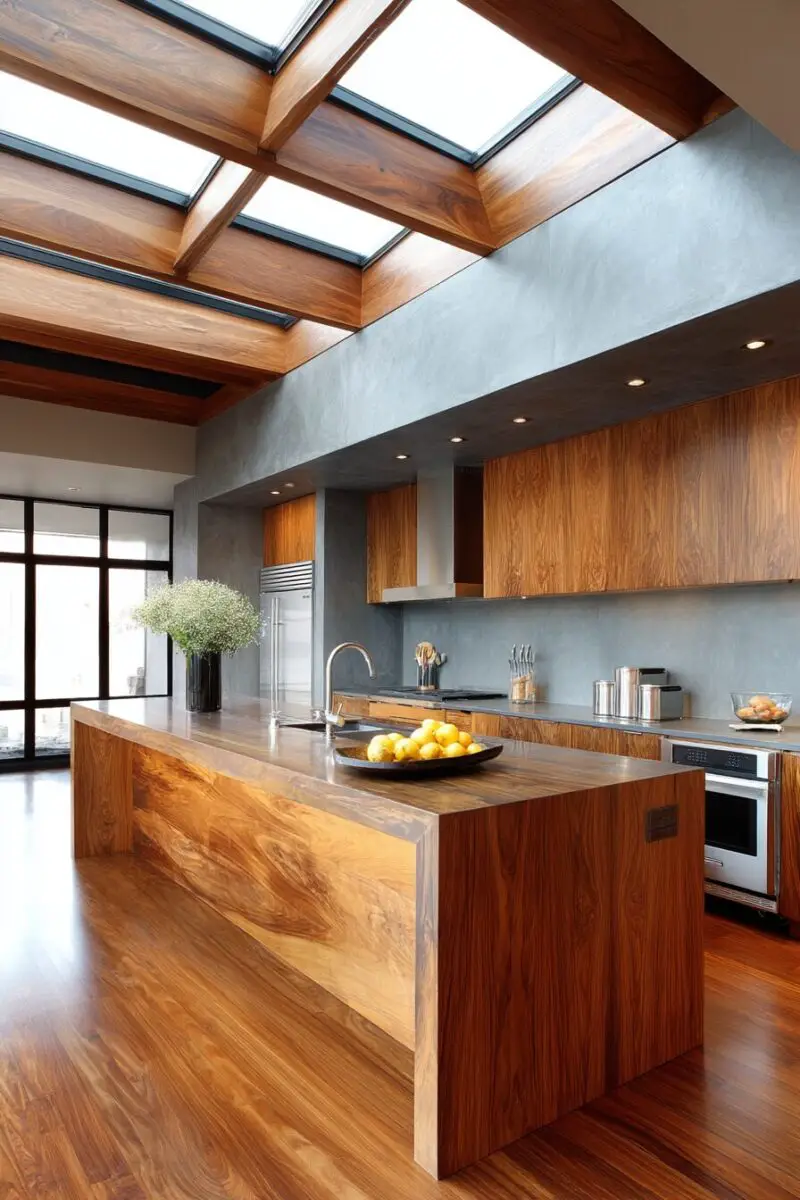
Those honey-colored pine cabinets and rich walnut countertops aren’t just furniture – they’re living connections to the forests that have sheltered generations, bringing nature’s warmth directly into your daily cooking rituals.
Natural wood elements form the backbone of any authentic grandmacore kitchen, offering timeless appeal that actually improves with age and use.
Unlike today’s trend toward sleek, minimal kitchens, grandmother’s cooking spaces embraced wood’s character – the knots, grain patterns, and gradual patina that developed through years of faithful service.
Butcher block countertops represent perhaps the most iconic grandmacore wood element, providing both beauty and functionality as they bear the marks of countless meals prepared.
These working surfaces tell stories through their knife marks and subtle stains, each one a record of family gatherings and everyday sustenance.
Open shelving crafted from reclaimed barn wood or vintage lumber introduces history and texture while providing practical display space for your treasured kitchen collections.
For cabinetry, look beyond perfectly matched sets to the charm of pieces that appear collected over time – perhaps lower cabinets in warm oak with upper shelving in a contrasting pine.
The gentle glow of naturally finished wood creates unmatched ambiance, especially when illuminated by morning sunlight streaming through kitchen windows.
Cabinet doors with simple raised panels or beadboard inserts capture grandmother’s era more authentically than flat modern styles, while bin pulls and cup handles in aged brass or iron complete the period look.
A farmhouse table with turned legs serving as both work surface and gathering place anchors the space with its substantial presence and invitation to linger.
Traditional wood chairs with spindle backs or simple ladder designs, perhaps mismatched over years of additions, create an unfussy, lived-in feeling around your dining area.
The natural variation in wood tones creates visual warmth through contrast – perhaps darker walnut accents against medium pine cabinetry or lighter maple floors.
Avoid the temptation to paint all wood surfaces in pursuit of trendiness – grandmother’s kitchen embraced wood’s natural beauty rather than concealing it.
For truly authentic character, look for vintage wooden elements at estate sales or architectural salvage yards – perhaps a baker’s cabinet with flour sifter, a hoosier cabinet, or solid wood pantry doors.
When selecting wood finishes, choose oil-based treatments that protect while allowing the wood to breathe and develop character rather than plastic-like polyurethane that seals wood under an artificial barrier.
Remember that grandmacore wood isn’t pristine – the occasional water ring, knife mark, or gentle wear speaks to a kitchen that prioritizes living over showcasing.
The tactile pleasure of wooden elements – the smooth edge of a well-worn counter or the substantial feel of a wooden spoon drawer pull – adds sensory richness to your daily kitchen experience.
Handmade Textile Touches

Those embroidered tea towels hanging from your oven door aren’t just decorative fabric – they’re tangible connections to the hands that stitched them, infusing your kitchen with irreplaceable warmth that no mass-produced item could ever deliver.
Handmade textiles transform utilitarian kitchen spaces into deeply personal environments, each piece telling stories of the time, skill, and care invested in its creation.
Cross-stitched samplers framed above the sink, hand-embroidered dish towels with vegetable motifs, crocheted pot holders in cheerful colors – these humble items formed the decorative backbone of grandmother’s kitchen.
The beauty of textile touches lies in their perfect balance of practicality and artistry – items meant for daily use while simultaneously bringing beauty and color to the space.
Window treatments offer prime opportunities for textile expression – cafe curtains in vintage-inspired patterns, valances with hand-crocheted edging, or simple linen panels with delicate embroidery along the hems.
Chair cushions covered in repurposed feed sacks or reproduction fabrics bring pattern and comfort to dining areas while honoring traditional textile arts.
For contemporary households seeking grandmacore charm, learning basic embroidery skills allows you to create your own heirloom pieces – perhaps starting with simple cross-stitch patterns on dish towels or napkins.
Look beyond purely decorative elements to the practical textiles that defined grandmother’s kitchen – sturdy cotton aprons with deep pockets, cloth bread bags that kept loaves fresh, or simple table linens used daily rather than saved for special occasions.
The tactile richness of natural fibers – cotton, linen, and wool – contribute significantly to the authentic feel of grandmacore design, each offering distinct textures that synthetic materials can’t replicate.
Rotating textile elements seasonally creates visual freshness while honoring traditions – spring flowers embroidered on napkins, summer fruit motifs on table runners, autumn harvest themes on placemats, and winter holidays celebrated through special linens.
For a truly cohesive look, choose a limited color palette for your textile collection, perhaps focusing on traditional combinations like red and white, blue and yellow, or soft pastels against neutral backgrounds.
Remember that grandmacore textiles weren’t pristine museum pieces but working elements of daily life – embrace the gentle fading, minor stains, or careful mending that speaks to items truly loved and used.
The sound of linens snapping as you unfold a freshly laundered tablecloth, the whisper of cotton curtains in a summer breeze – these sensory experiences add immeasurable richness to your kitchen atmosphere.
Hand-knitted dishcloths in simple patterns offer both practicality and the special charm that comes from items created stitch by stitch rather than rolled out by machines.
Display your everyday textile items proudly – a collection of vintage-inspired dish towels hanging from hooks, a special apron on display when not in use, or a bread cloth draped over a rising bowl.
The ultimate grandmacore textile might be the cherished recipe cloth – printed cotton featuring handwritten family recipes preserved in fabric form, framed as kitchen art or actually used as a reference while cooking.
Practical Pantry Organization with Glass Jars and Labeled Containers

Those gleaming glass canisters lining your pantry shelves aren’t just storage solutions – they’re transparent time capsules connecting modern convenience with grandmother’s practical wisdom about reducing waste and appreciating visual abundance.
Before plastic dominated kitchen storage, generations of home cooks relied on glass jars, crocks, and metal tins to keep pantry staples fresh and easily accessible.
The beauty of grandmother’s pantry organization lies in its perfect marriage of functionality and display – dry goods becoming decorative elements while remaining perfectly practical.
Mason jars in various sizes stand as perhaps the most iconic pantry storage, their versatility stretching from preserving summer’s bounty to organizing everything from pasta to baking ingredients.
Vintage general store containers and authentic old-fashioned canisters can be found at antique markets, bringing genuine history to your organization system through their aged patinas and period typography.
For a truly authentic touch, handwrite labels on kraft paper tags tied with twine or use a vintage label maker to create that distinctive embossed tape that adorned grandmother’s carefully organized spaces.
The transparency of glass storage creates practical advantages beyond aesthetics – allowing you to quickly assess inventory levels and inspiring cooking based on what’s visually appealing at any given moment.
Dedicated sections for different flours, sugars, and grains transform everyday ingredients into a visually satisfying display while making baking projects more intuitive and enjoyable.
Wire baskets holding potatoes, onions, and garlic create breathable storage for root vegetables while adding textural contrast to glass and ceramic containers.
Remember that grandmother’s pantry embraced natural materials – wood, glass, ceramic, and metal – rather than the plastic that dominates modern storage solutions.
Repurpose vintage items in unexpected ways – perhaps a muffin tin becoming a spice organizer, a bread box storing recipe cards, or creamers repurposed as containers for small pantry items.
The gentle routine of transferring grocery items into permanent containers connects you with generations of home cooks who understood this small act as both practical housekeeping and mindful preparation.
Unlike hidden storage behind solid cabinet doors, grandmother’s pantry organization celebrated visual accessibility – items within easy reach and sight for efficient meal preparation.
For open shelving areas, consider the color story created by your stored items – perhaps grouping by color family or creating pleasing transitions from one hue to the next.
Don’t overlook the sensory pleasure of this organization system – the satisfying “pop” of a lid opening, the whisper of grains being poured, or the visual delight of layered ingredients in clear containers.
The inherent honesty of visible storage encourages mindful consumption and reduces waste – grandmother’s practical wisdom about using what you have before buying more embedded in the very system itself.
Herb Gardens and Natural Elements
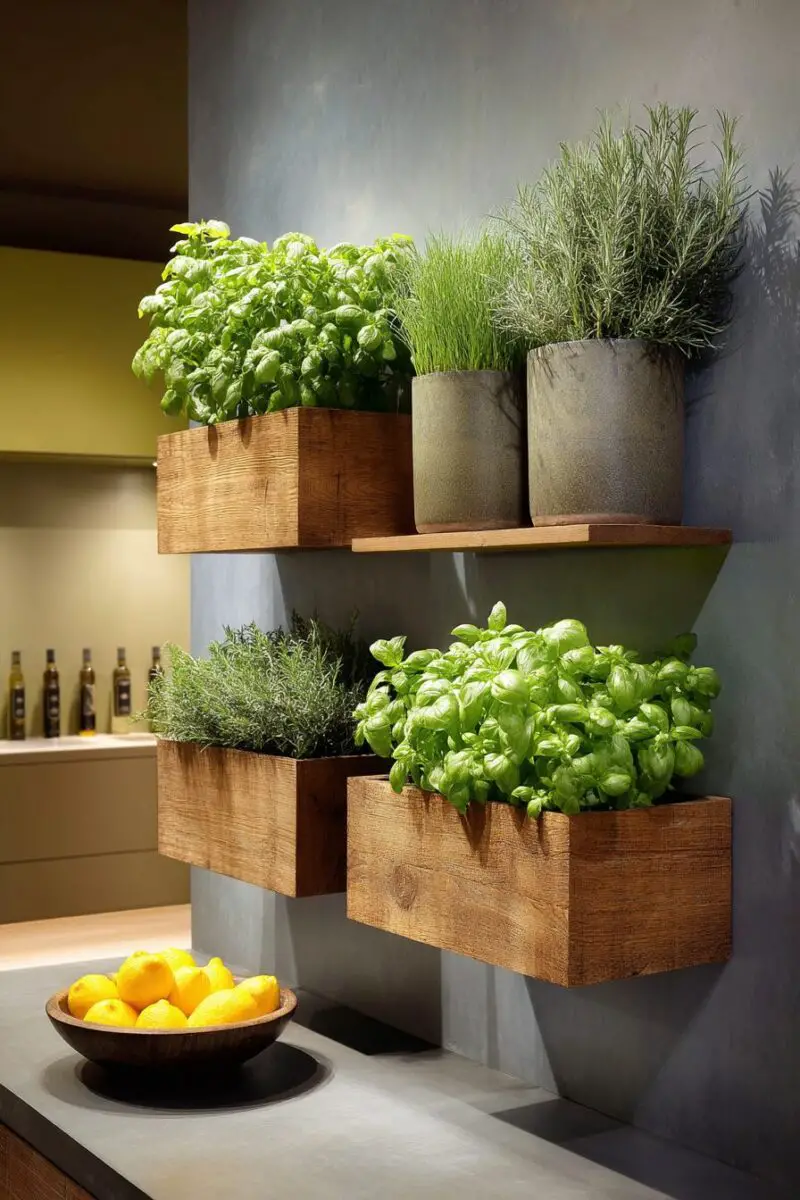

That compact herb garden flourishing on your windowsill isn’t just a convenient source of fresh flavors – it’s a living connection to grandmothers who understood the profound magic of nurturing plants that would, in turn, nurture their families.
Kitchen herb gardens represent one of the most authentic touches in grandmacore design, bridging the gap between outdoor gardening traditions and practical indoor cooking needs.
The gentle fragrance of rosemary, basil, and mint creates an immersive sensory experience that no scented candle or air freshener could hope to replicate.
Window-mounted shelving designed specifically for herbs maximizes limited space while ensuring plants receive adequate sunlight – a practical consideration grandmothers understood intuitively.
The vibrant greens of various herbs create living decoration that changes subtly with seasons and care, responding to your attention in ways static decor elements never could.
For authentic grandmacore charm, label your herbs with handwritten markers on popsicle sticks or repurposed silver spoons pressed flat and stamped with plant names.
Beyond traditional culinary herbs, include edible flowers like nasturtiums or pansies that can grace both your windowsill and your dinner plate with their cheerful presence.
The gentle routine of watering, pruning, and harvesting connects you with natural rhythms often lost in modern life – a mindful practice grandmother would certainly approve of.
Dried flower bundles hanging from ceiling beams, lavender sachets tucked in drawers, or rosehips gathered in small bowls bring nature’s bounty indoors in traditional ways that plastic plants could never capture.
Fresh-cut flowers from the garden arranged simply in repurposed containers – perhaps a blue mason jar or cream pitcher – add ever-changing color and life to your countertops.
Remember that grandmother’s approach to natural elements was inherently sustainable – growing what was needed, preserving seasonal abundance, and finding beauty in items already on hand.
Integrate natural materials throughout your kitchen design – stone countertops, wooden cutting boards, cotton textiles, and ceramic containers all supporting the connection to the natural world.
Bird feeders positioned outside kitchen windows extend the natural experience beyond indoor space, creating living entertainment that connects indoor cooking areas with outdoor landscapes.
The subtle sounds of nature – rain against windows while herbs release their scent from the warmth of a nearby stove, birdsong accompanying morning coffee preparation – add auditory richness to your kitchen experience.
For seasonal celebrations, bring nature’s changes indoors through pinecone arrangements in fall, forced bulbs in winter, pussy willow branches in spring, and sunflower displays in summer.
Rather than purchasing herb plants repeatedly, embrace grandmother’s practice of propagation – rooting cuttings in water before transplanting, saving seeds, and dividing established plants to expand your collection.
✨Click to Get My 101 FREE Designer Room Ideas
Cozy Breakfast Nook with Cushioned Seating


That sun-drenched corner with its built-in benches and welcoming cushions isn’t just a dining spot – it’s a sanctuary where morning coffee becomes meditation, everyday meals transform into memory-making moments, and the simple act of gathering nurtures bonds that transcend generations.
Breakfast nooks represent perhaps the most quintessential grandmacore kitchen feature, capturing the essence of comfort, practicality, and familial connection in one perfectly designed space.
The genius of these dedicated dining areas lies in their inherent coziness – typically featuring L-shaped or U-shaped bench seating that maximizes seating capacity while creating natural intimacy among diners.
Unlike formal dining rooms saved for special occasions, breakfast nooks invite daily use through their accessible location and comfortable informality that encourages lingering over coffee or homework help.
Window placement plays a crucial role in traditional breakfast nooks, with natural light streaming in to create that magical morning glow that somehow makes everything from toast to serious conversations more appealing.
Cushions upholstered in washable fabrics with cheerful patterns create inviting comfort while acknowledging the practical reality of kitchen spills and everyday use.
For authentic grandmacore charm, mix patterns thoughtfully – perhaps floral cushions paired with gingham tablecloths or striped pillows against solid upholstery.
Built-in storage beneath bench seating offers practical advantages, providing perfect homes for seldom-used serving pieces, seasonal linens, or children’s art supplies for keeping little ones entertained during meal preparation.
The slightly enclosed nature of breakfast nooks creates natural sound buffering, making conversations more intimate and helping multiple generations hear each other better across the table.
Personalize your nook with wall space dedicated to family photos, children’s artwork in simple frames, or a collection of plates that tell your family’s story through their patterns or origins.
For maximum flexibility, consider bench cushions with removable, washable covers in seasonal fabrics that can be changed to reflect holidays or simply refresh your kitchen’s look.
Unlike chairs that can be pushed back at awkward angles, bench seating creates natural tidiness that would appeal to grandmother’s sense of order without sacrificing comfort.
The psychology of booth-style seating naturally encourages longer, more meaningful conversations – the slight enclosure creating a sense of safety that opens hearts as well as appetites.
For the finishing touch, incorporate a small shelf running along the back of the bench area, creating the perfect spot for everyday items like sugar bowls, napkin holders, or small plants.
Remember that genuine breakfast nooks weren’t pristine showcases but hardworking family spaces – embrace the slight wear on bench edges, the cushion that bears the impression of years of use, or the table surface marked by countless meals.
Nostalgic Decorative Accessories
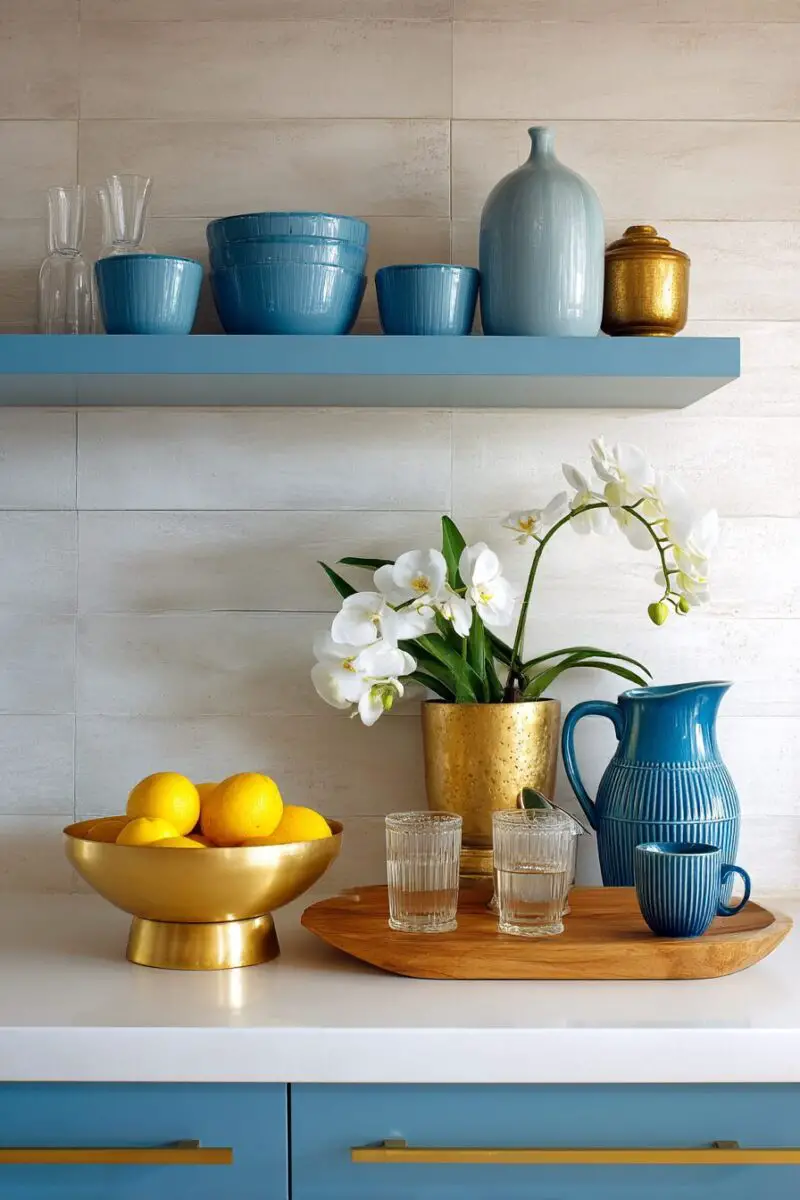
Those carefully arranged copper molds and hand-painted salt cellars adorning your kitchen walls aren’t just decorative objects – they’re memory keepers connecting your modern life to grandmothers who understood that beautiful tools used daily infuse ordinary moments with extraordinary meaning.
Decorative accessories in grandmother’s kitchen served dual purposes – adding visual warmth while remaining genuinely useful components of daily cooking and dining rituals.
Unlike today’s purely decorative items, traditionally every kitchen ornament had a practical origin – the wooden butter molds displayed on shelves once pressed patterns into fresh dairy, the colorful rolling pins hanging in a collection actually rolled countless pie crusts.
Family heirlooms take center stage in grandmacore kitchens – perhaps great-grandmother’s cookie cutters arranged in a shadow box or grandfather’s fishing creel repurposed as unique storage.
For authentic charm, focus on collecting items with visible history – the copper pot with minor dents from decades of use or ceramic mixing bowls with crazing that speaks to countless batters mixed.
Vintage tins with their charming typography and illustrations make perfect containers for modern storage needs while adding authentic color and character to open shelving.
Cookie jars deserve special mention in any grandmacore kitchen, their whimsical shapes and nostalgic designs promising sweetness while standing guard on countertops like cheerful sentinels.
For a touch of practical whimsy, vintage salt and pepper shakers displayed in small collections bring conversation-starting charm to tables and countertops.
Hand-colored recipe cards framed under glass preserve family food traditions while simultaneously adding authentic typography and handwritten charm to your walls.
Vintage kitchen scales with their honest mechanical simplicity and aged patina make perfect countertop accessories that combine visual appeal with occasional practical use.
Glass refrigerator dishes in jewel tones displayed on open shelving create colorful focal points while standing ready for leftovers – the perfect merger of decoration and functionality.
Look for authentic vintage calendars, advertising thermometers, or grocery store signs at flea markets to add typographic interest and historical connections to your walls.
Remember that grandmother’s decorative approach wasn’t minimalist – embrace the layered, collected-over-time abundance that characterized traditional kitchens before modern design demanded ruthless editing.
Unlike mass-produced decor items designed to mimic aging, authentic vintage pieces carry genuine energy of the hands that used them – a subtle but meaningful difference in creating a space that feels genuinely soulful.
Rotate decorative elements seasonally to keep your kitchen feeling fresh – grandmother’s practical wisdom understood that special items appreciate when they’re not constantly in view.
Creating a grandmacore kitchen isn’t about perfectly replicating the past or following rigid design rules.
Instead, this heartwarming style invites you to blend cherished traditions with practical modern needs, crafting spaces where memories naturally form around everyday moments.
The most authentic grandmacore kitchens grow organically over time, accumulating stories alongside recipes and embracing the beautiful imperfections that speak to a life well-lived.
By incorporating these ten elements in ways that honor your own family history and practical needs, you’ll create not just a stylish cooking space, but a true heart for your home that welcomes generations to gather, nourish, and connect.

